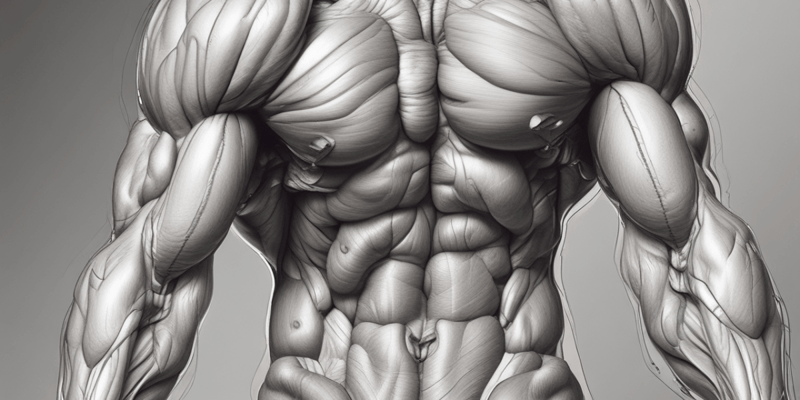Podcast
Questions and Answers
What characterizes a motor unit?
What characterizes a motor unit?
Which factor primarily influences the graded increase in muscle contraction strength?
Which factor primarily influences the graded increase in muscle contraction strength?
What occurs during tetanus in skeletal muscle?
What occurs during tetanus in skeletal muscle?
How does the length-tension relationship affect contraction strength?
How does the length-tension relationship affect contraction strength?
Signup and view all the answers
Which best describes the mechanism of force variation in skeletal muscle?
Which best describes the mechanism of force variation in skeletal muscle?
Signup and view all the answers
What limitation exists when sarcomeres are overstretched?
What limitation exists when sarcomeres are overstretched?
Signup and view all the answers
What is the result of recruiting larger motor units first during muscle contraction?
What is the result of recruiting larger motor units first during muscle contraction?
Signup and view all the answers
Which muscle type does NOT rely on action potentials generated from autonomic nerves for contraction?
Which muscle type does NOT rely on action potentials generated from autonomic nerves for contraction?
Signup and view all the answers
What happens to muscle units during prolonged contractions?
What happens to muscle units during prolonged contractions?
Signup and view all the answers
Which of the following best differentiates smooth muscle from skeletal and cardiac muscle?
Which of the following best differentiates smooth muscle from skeletal and cardiac muscle?
Signup and view all the answers
Study Notes
Muscle Components
- Each muscle fiber contains multiple myofibrils, which are composed of repeating units called sarcomeres.
Muscle Strength and Contraction
-
Length-Tension Relationship: The force a muscle generates during contraction is directly related to its resting length.
- Optimal Resting Length: There is an optimal resting length for the sarcomere where maximum strength of contraction can be achieved.
- Overstretched Sarcomere: When a sarcomere is overstretched, there is no overlap between actin and myosin filaments, leading to reduced tension.
-
Force/Strength of Contraction: The force of muscle contraction can be varied through two mechanisms:
-
Tetanus: When a muscle is stimulated repeatedly at a high frequency, it leads to a sustained contraction known as tetanus.
- Tetanus is caused by temporal summation of action potentials, which results in an increase in intracellular calcium concentration.
-
Motor Unit Recruitment: A motor unit consists of a motor neuron and all the muscle fibers it innervates.
- The size of a motor unit determines the precision of control over a muscle.
- Smaller motor units are recruited first to generate smaller forces, while larger motor units are recruited as more force is needed.
- During prolonged contractions, motor units are recruited in a rotating pattern, allowing some units to rest while others contract, delaying fatigue.
-
Tetanus: When a muscle is stimulated repeatedly at a high frequency, it leads to a sustained contraction known as tetanus.
Cardiac Muscle Contraction
- The cardiac muscle action potential has a prolonged plateau phase, which ensures a long duration of contraction, allowing for the efficient pumping of blood.
-
Mechanism of Contraction:
- Cardiac muscle contraction is initiated by calcium influx from the extracellular space.
- Calcium binds to troponin, triggering the exposure of binding sites on actin filaments.
- Myosin heads attach to actin, causing sliding of filaments and muscle contraction.
- Relaxation occurs when calcium is pumped back out of the cell.
Smooth Muscle Contraction
-
Mechanism of Contraction:
- Smooth muscle contraction is initiated by calcium influx from the extracellular space or internal stores.
- Calcium binds to calmodulin, activating myosin light chain kinase (MLCK).
- MLCK phosphorylates myosin, allowing it to bind to actin and initiate the sliding filament mechanism.
- Relaxation occurs when calcium is pumped back into storage and MLCK activity decreases.
Differences in Muscle Types
-
Skeletal Muscle:
- Voluntary control
- Striated appearance due to sarcomere organization
- Fast contraction speed
- Fatigue prone
-
Cardiac Muscle:
- Involuntary control
- Striated appearance
- Intermediate contraction speed
- Fatigue resistant
-
Smooth Muscle:
- Involuntary control
- Non-striated appearance
- Slow contraction speed
- Fatigue resistant
Studying That Suits You
Use AI to generate personalized quizzes and flashcards to suit your learning preferences.
Related Documents
Description
Test your understanding of muscle components and the mechanics of muscle contraction. This quiz covers key concepts such as the length-tension relationship, optimal resting length, and the mechanisms behind tetanus and motor unit recruitment. Enhance your knowledge of how muscles generate force and perform actions.




